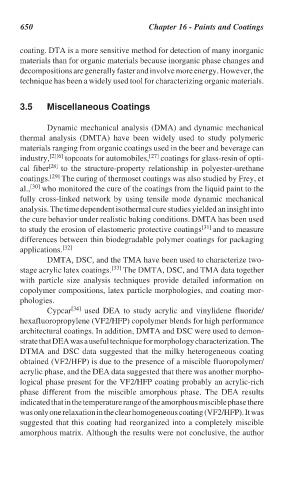Page 682 - Handbook of Thermal Analysis of Construction Materials
P. 682
650 Chapter 16 - Paints and Coatings
coating. DTA is a more sensitive method for detection of many inorganic
materials than for organic materials because inorganic phase changes and
decompositions are generally faster and involve more energy. However, the
technique has been a widely used tool for characterizing organic materials.
3.5 Miscellaneous Coatings
Dynamic mechanical analysis (DMA) and dynamic mechanical
thermal analysis (DMTA) have been widely used to study polymeric
materials ranging from organic coatings used in the beer and beverage can
industry, [2][6] topcoats for automobiles, [27] coatings for glass-resin of opti-
cal fiber [28] to the structure-property relationship in polyester-urethane
coatings. [29] The curing of thermoset coatings was also studied by Frey, et
al., [30] who monitored the cure of the coatings from the liquid paint to the
fully cross-linked network by using tensile mode dynamic mechanical
analysis. The time dependent isothermal cure studies yielded an insight into
the cure behavior under realistic baking conditions. DMTA has been used
to study the erosion of elastomeric protective coatings [31] and to measure
differences between thin biodegradable polymer coatings for packaging
applications. [32]
DMTA, DSC, and the TMA have been used to characterize two-
stage acrylic latex coatings. [33] The DMTA, DSC, and TMA data together
with particle size analysis techniques provide detailed information on
copolymer compositions, latex particle morphologies, and coating mor-
phologies.
Cypcar [34] used DEA to study acrylic and vinylidene fluoride/
hexafluoropropylene (VF2/HFP) copolymer blends for high performance
architectural coatings. In addition, DMTA and DSC were used to demon-
strate that DEA was a useful technique for morphology characterization. The
DTMA and DSC data suggested that the milky heterogeneous coating
obtained (VF2/HFP) is due to the presence of a miscible fluoropolymer/
acrylic phase, and the DEA data suggested that there was another morpho-
logical phase present for the VF2/HFP coating probably an acrylic-rich
phase different from the miscible amorphous phase. The DEA results
indicated that in the temperature range of the amorphous miscible phase there
was only one relaxation in the clear homogeneous coating (VF2/HFP). It was
suggested that this coating had reorganized into a completely miscible
amorphous matrix. Although the results were not conclusive, the author

